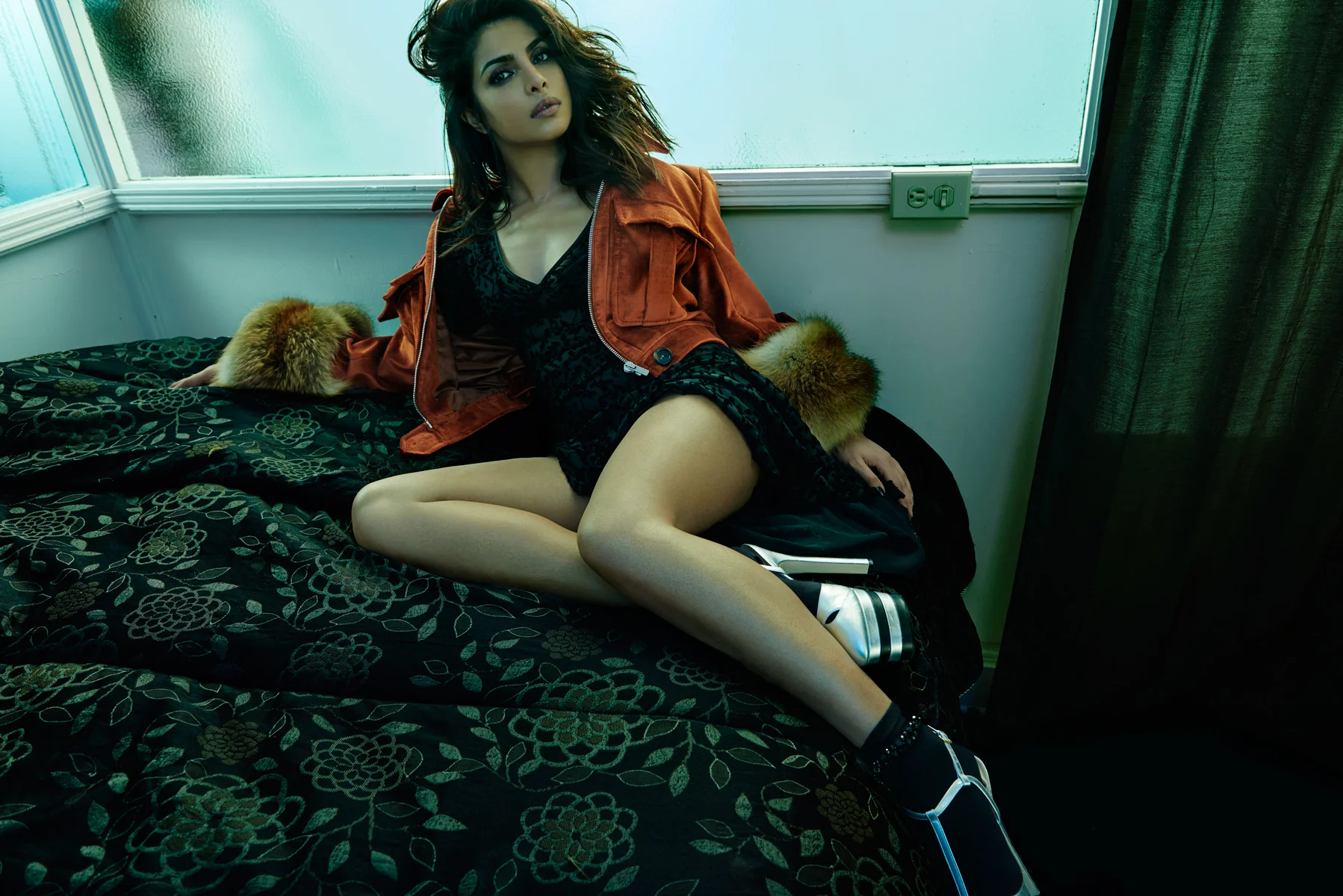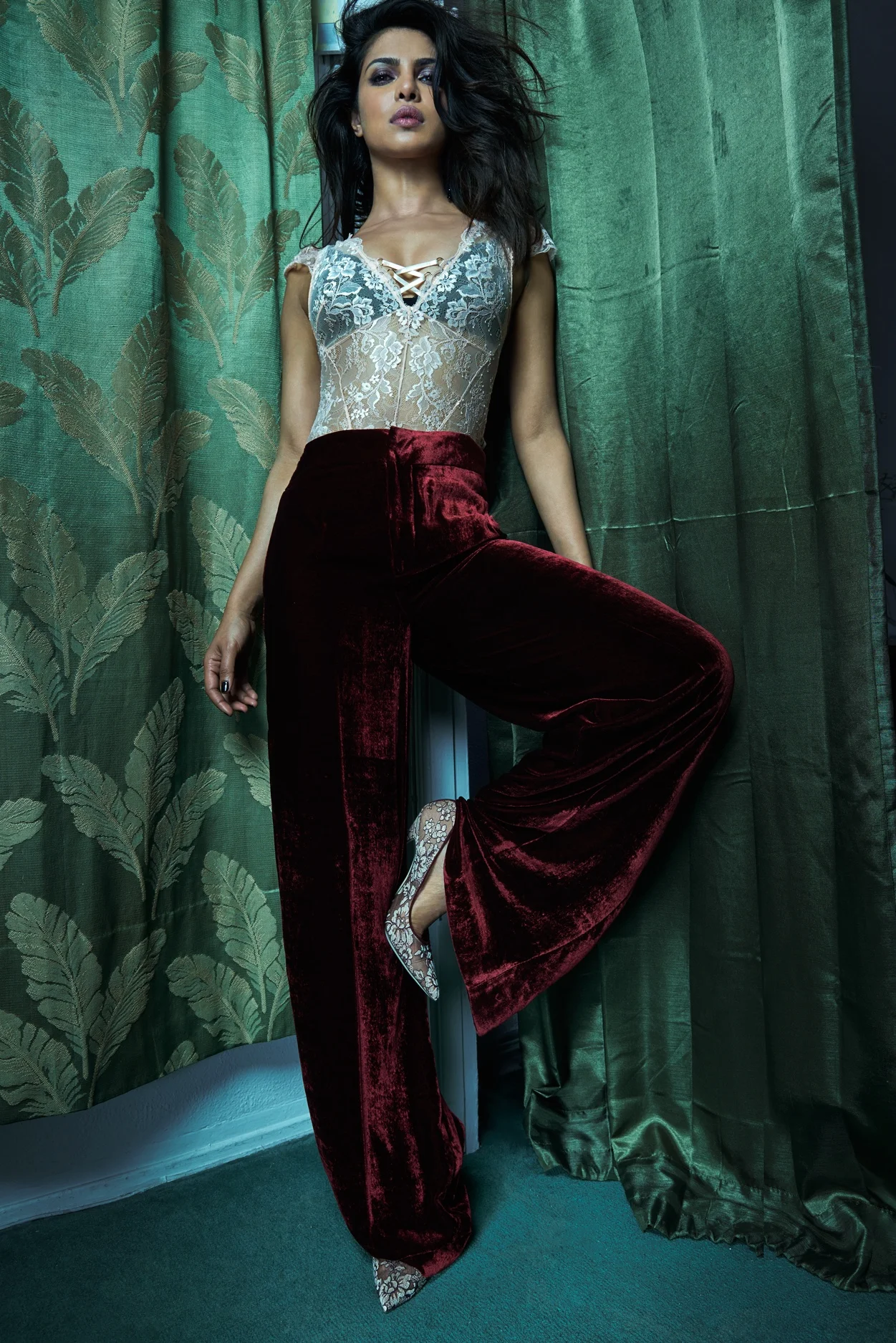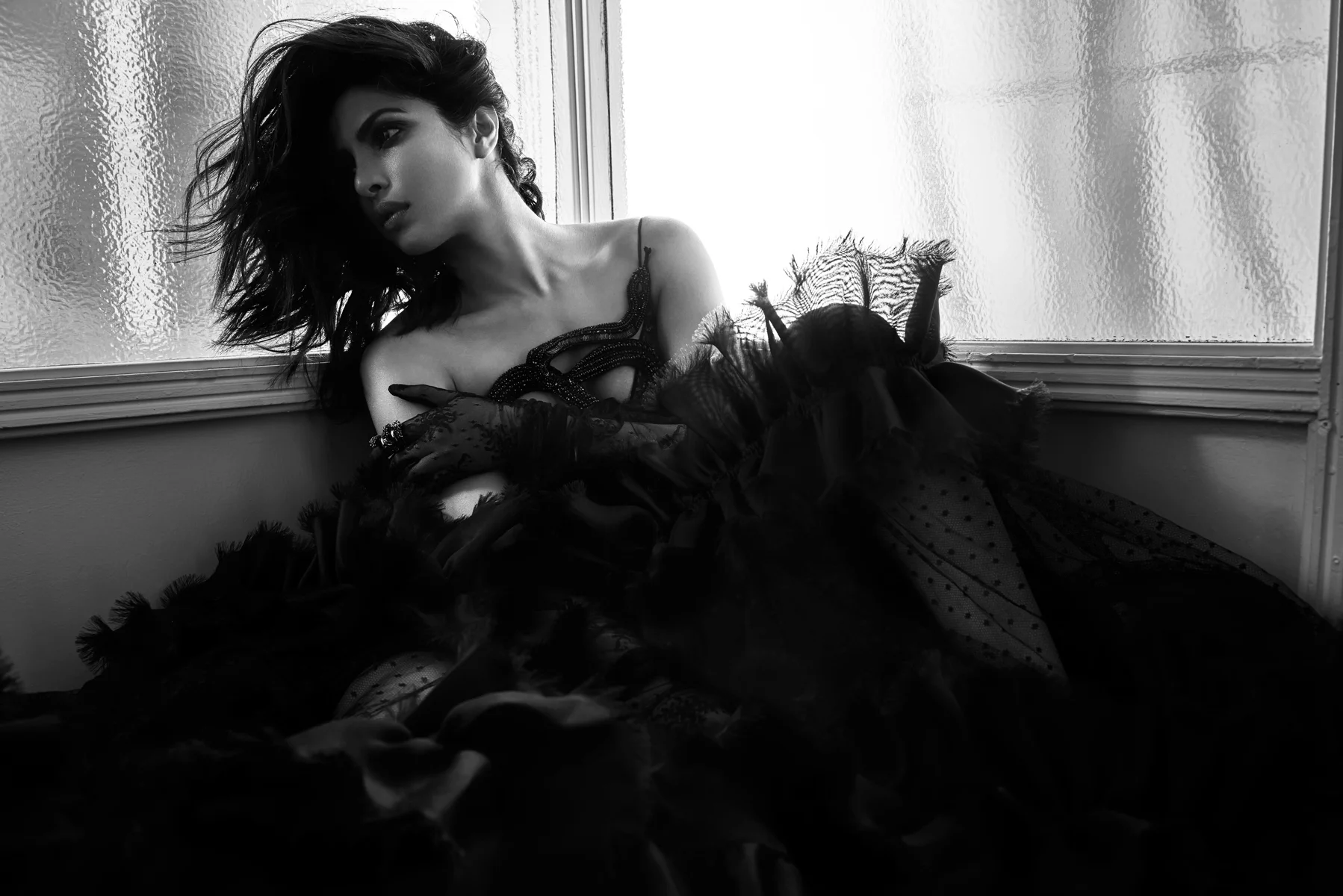
ETRO dress, PRADA belt, and stylist’s own bra and choker

JILL STUART top, PREEN BY THORNTON BREGAZZI dress, ROCHAS earrings, and GUCCI ring

MIU MIU jacket, YIGAL AZROUEL dress, GUCCI shoes, and SIMONE ROCHA socks

AGENT PROVOCATEUR bodysuit, stylist’s own bra, ETRO pants, and JIMMY CHOO shoes

GUCCI dress, gloves, and ring.
[](#)[](#)
Priyanka Chopra
“Pop culture influences change so much in such a subliminal way, I want to be a part of that. It’s so much easier to do an artsy thing, and say, ‘this is my art.’"
#### It is only those who know neither an inner call nor an outer doctrine whose plight truly is desperate; that is to say, most of us today, in this labyrinth without and within the heart.
— Joseph Campbell, The Hero with a Thousand Faces (1949)
There are many writers who have waxed on about the electromagnetic properties of fame—about the energy that is imparted on an individual once they become a household name to a significant enough proportion of the population. As I sit across from Priyanka Chopra—known simply as P.C. to the one and a quarter billion people in her native India, and a rising proportion of the rest of the world—while she is whisked from a photo shoot in downtown L.A. to her Beverly Hills hotel, I can understand why.
To say that the actress/writer/singer/ producer/philanthropist’s magnetism comes from her fame is to confuse causation and correlation. As she flips her perfectly tousled hair, and answers my questions in a voice that is at once gravelly and honeyed, it is apparent that the force that has driven the 33-year-old overachieving daughter of two doctors from the prestigious La Martinière Girls’ School to winning the Miss India competition; to winning the Miss World competition; to over 50 Bollywood films; to starring in ABC’s _Quantico_; to the upcoming _Baywatch_ reboot... has nothing to do with how she looks or how many people know her name.
In Joseph Campbell’s seminal work, _The Hero with a Thousand Faces_, he identities several themes found in major heroic myths—from Osiris to Prometheus to the Buddha—that speak to the hero’s origins, and what makes them exceptional. Here, we use these motifs to identify the heroic demarcations in Priyanka Chopra’s story.
Part I: The Ordinary World
At nine years old, Chopra was shown how fortunate her life was compared to many Indian people. Her mother—an OBGYN—decided that, instead of the roster of holiday plans Chopra had lined up, she would accompany her parents on the rounds they made to local villages to treat the girls and women. In those villages she saw girls who were kept at home when their brothers were sent to school. These young women were told that education was no use to them because they would be married off anyway. “That gets me,” Chopra says, “Because that was the one thing my parents always allowed me to have. Every year I used to change what I wanted to be, every year I would tell my mom ‘I want to be a pilot,’ ‘I want to be a maid,’ ‘I want to be a cook,’ ‘I want to be a ballerina,’ I want to play the drums,’ and I did all of it! My parents never made me feel that there was anything wrong with it.” Chopra cites this early influence as the reasoning behind her charity foundation—which provides healthcare and education fees for approximately 70 children in India—and her work with UNICEF (she became a Goodwill Ambassador in 2010).
Part II: Call To Adventure
“I left from the time I was 12 to 16 \[to study abroad\] and when I came back I had grown into this pretty, feminine thing, from being a tomboy with scratched out knees,” says Chopra. We’re talking about her entrance into the Miss India competition. Chopra and her mother were taking pictures at a photo studio for a scholarship program that she was applying for and the photographer asked if he could take a few more. Her mother sent those in to the competition and Chopra was invited to compete. “I just wanted to skip my pre-boards (which are our prep exams for our major exams in 12th grade), and I just never thought I’d win. My mom didn’t think I’d win. Nobody thought I’d win—I had never even worn heels in my life!” Chopra pauses for a beat, brushing her hair from her face, “But I did, and after that I ended up winning Miss World.”
Those early wins stoked a re that had fueled her through a childhood and adolescence tinged by adult truths: Chopra was bullied for the color of her skin and her accent when living with relatives in New England, and the only character on television that looked and talked like her was Apu of _The Simpsons_. After Miss World, it was as if Chopra made a pact with herself to take on the world.
Part III: Crossing The Threshold
Chopra tenses a bit when she talks about the American conception of Bollywood, and rightfully so. For an industry that is one of the largest in the world—producing about 800 films and selling four billion tickets a year—the Hindi film business is largely misunderstood within the United States, and usually relegated to the same category as Broadway musicals and Renaissance Fairs: all well and good if that’s what you’re into. This attitude ignores the “hindie” lm movement—smaller, independent films that tackle more difficult subject matter—which has been gaining momentum for the last decade or so. Films like _Aligarh_ (2015)—which tells the story of a school teacher who was suspended from his job because of his sexual orientation—exemplify the new Bollywood, one which caters to an audience who grew up consuming an international entertainment diet.
While many foreign stars dream about ‘crossing over’ to American entertainment, Chopra expected to be wooed. After starring in her first lm at age 21 in _Andaaz_ (2003), the next year she achieved critical and commercial success in _Aitraaz_ (2004) as Mrs. Sonia Roy, a woman who accuses her ex-lover of raping her, and is sued by him for sexual harassment. The role was a turning point for Chopra, who went on to play meatier parts and is now, notably, one of the highest paid actresses in Bollywood.
When ABC approached Chopra to be the lead in a new series, they did so with 26 pilots for her to choose from. I ask her why she chose _Quantico_, a show based around several young FBI recruits told partly in flashbacks as Chopra’s character is questioned and forced on the lam after a major terror attack. “It was quintessential television,” she says, “It was everything I would want to watch in a show.”
Chopra doesn’t mince words when it comes to her goals. Earlier in the conversation, when I venture that—for someone as famous as she is—fame and money don’t seem to be her goal, she responds, “Pop culture influences change so much in such a subliminal way, I want to be a part of that. It’s so much easier to do an artsy thing, and say, ‘this is my art.’ I’m a sensible person, and I truly believe that box office is king. I truly believe that we are in the business of entertainment. To be able to find the amalgamation of business and art—that’s fun, that’s a win on every level.”
Part IV: Tests, Allies, Enemies
If _Aitraaz_ gave Chopra a taste of what it was like to play the villain, she got the full meal filming _Baywatch_. “Victoria Leeds \[my role in Baywatch\] was written for a guy first—a male villain,” she explains when I ask about her role, “And it’s so much fun because, Dwayne \[Johnson\] was telling me after we finished one scene, ‘I’ve actually never had a nemesis I haven’t crushed before, I can’t do that to you because you’re just mean.’” She lets out a rolling, cornhusk-dry laugh, “I’m just really mean in the film—you know when you don’t know what to do with someone who’s just unapologetically patronizing, and condescending? What do you say to someone like that?” I ask Chopra if she prefers to play the villain versus the hero. “There are pros and cons to both,” she replies, “If you don’t pull it off, you’re screwed, and people are like, ‘Oh, girls can’t be villains,’ but I find it liberating, because when are we ever going to be so bad in real life? It’s so much fun to be bad—it’s luxurious.”
I get the feeling that like many people who have risen above their assigned station in life, Chopra carries the knowledge that if she fails, she fails not as Priyanka Chopra, but as all driven women of color. “You’re known by your last failure,” she says to me earlier in the ride, “People don’t remember success as much. They’ll acknowledge it, and they’ll say, what are they going to do next? Where is the failure going to come?”
Part V: Approach To The Inmost Cave
Chopra was recently on the cover of _Time_’s ‘100 Most Influential People.’ In the article, written by Dwayne Johnson, the actor says of his Baywatch co-star: “We always quote the saying ‘Wear your success like a t-shirt, not like a tuxedo.’” When I bring this up to Chopra she laughs with delight, “He stole that from me!” she says. It speaks well to her character that Chopra spends the majority of our interview talking about hard work and gratitude. When I ask her where she thinks her work ethic comes from she mentions her father, who was an army doctor but sadly passed away a few years ago. She carries a piece of him with her everywhere: a note in his rounded, looping handwriting tattooed on her wrist, it reads “Daddy’s lil girl...”
Her phone rings and she hands it to an assistant to take the call. We lapse into silence for a minute as the assistant arranges for someone to get a key from reception. Chopra folds her legs underneath her and looks out the window, “Success can’t be announced, like: ‘Here is a successful person and they are walking through the door,’” she muses, “it has to be discovered—stardom has to be discovered, and it has to be easy, and it has to be effortless. If you are aware of the fact that you are a star then you’re just not. That can’t be the agenda, that can’t be the reason. People who leave legacies, people who are real stars are just being—and it’s in their inherent being that you find stardust.”
Part VI: Ordeal
As the SUV approaches the hotel, I ask Chopra what’s next, and she confirms a much-needed vacation, saying, “I put my foot down, I said I want ten days to be at home with my family. Every hour of my life for the next six months is scheduled.” Her publicist in the front seat gives a knowing laugh, “It’s true!” she insists, “We know what we’re doing until December.”
I recall that at the beginning of the conversation I asked Chopra, in the spirit of the theme of this issue, what adventure meant to her. “Adventure is fearlessness,” she replied, “you can’t decide or plan an adventure. The point of an adventure is to not know what you are getting into, and to be in unfamiliar territory, to walk in without a plan—most people find that the hardest thing to do, most of us want to hold on to a sense of control.”
“So you’re not a control freak?” I ask.
“No, I am a control freak!” She flips her hair, turning towards me in her seat, “I delegate, but I need to see what’s done. So I control everything because I have a very set vision and mood about where my career is going, and it’s very organic, so I don’t like to conform it to a plan. I think I’m adventurous when it comes to my work, because I like to do things that are a little to the left, not conventional, yet within pop culture.”
We pull up in front of the hotel, and Chopra reaches over to hug me. She is still engaging, but I can feel her laser focus shifting—to dinner, packing, getting on the plane, seeing her family, an upcoming film festival in Spain, the London and Paris release of _Quantico_, filming the second season of _Quantico_, the rest of her life.
As I walk toward the street to meet my Uber I look back to see Chopra striding into the hotel lobby the same way she does everything: like she’s there to win.
#### Photographer: Frederic Auerbach for Opus Reps
#### Stylist: Zoe Costello for Jed Root Inc.
#### Hair: Christian Marc for Forward Artists
#### Makeup: Matthew Vanleeuwen for Starworks Group
Manicure: Lisa Pena-Wong for Opus Beauty using Maxus
Priyanka Chopra was featured in [2016 in Flaunt: A Few Favorites from a Fabulous Year](http://archive.flaunt.com/s/flaunt.com/people/2016-flaunt-favorites-fabulous-year2016-flaunt-favorites-fabulous-year?format=original)
